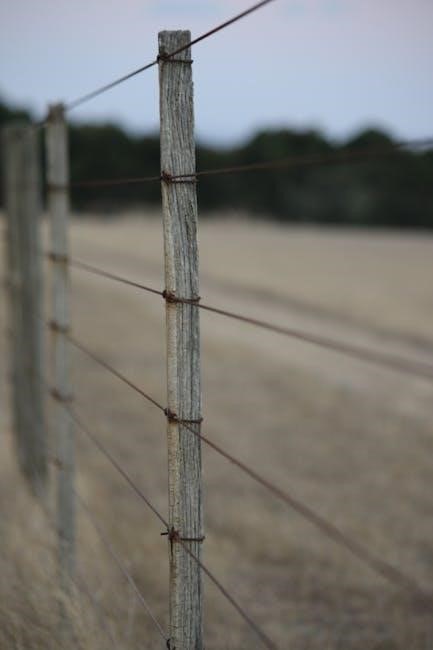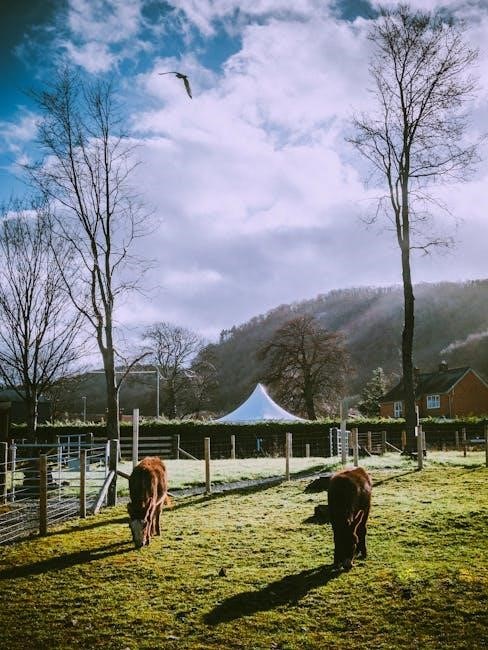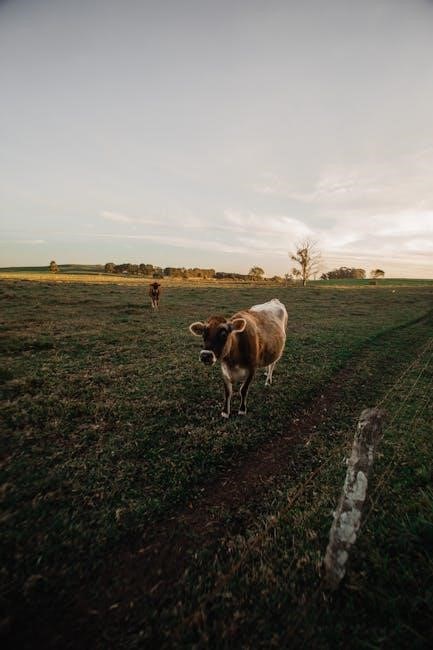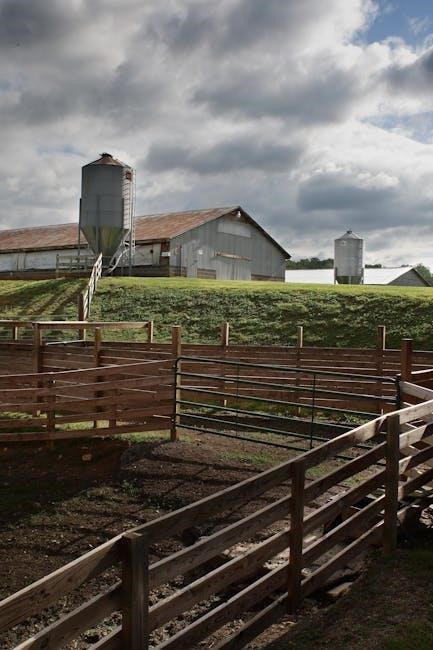farm fence post spacing guide
Farm fence post spacing is crucial for structural integrity, livestock safety, and cost-efficiency. Typical spacing ranges from 8 to 25 feet, depending on terrain, livestock type, and climate conditions.
Factors Influencing Fence Post Spacing
Terrain, livestock type, climate, and fence height significantly impact post spacing. Uneven land requires closer posts, while flat areas allow wider spacing. Livestock behavior and weather conditions also influence spacing decisions.
Terrain and Land Shape
The terrain and land shape significantly influence fence post spacing. On flat land, posts can be spaced farther apart, typically 8 to 12 feet, ensuring structural stability. However, uneven or hilly terrain requires closer spacing, often 6 to 8 feet, to maintain fence integrity. Slopes may need shorter spans to prevent sagging, while curves demand posts placed more frequently to follow the contour. Rocky or dense soil might require deeper post installation. Adjusting post spacing according to the land’s natural contours ensures the fence remains durable and visually appealing. Proper planning for terrain variations is essential to avoid costly repairs and maintain livestock containment.
Livestock Type and Behavior
Livestock type and behavior play a critical role in determining fence post spacing. Heavier animals, such as cattle or horses, require closer post spacing (6 to 8 feet) to prevent damage from pushing or leaning. Smaller animals, like sheep or goats, may need tighter spacing (4 to 6 feet) to prevent escape. Aggressive behaviors, such as rubbing or charging, also necessitate stronger fencing with shorter spans. For example, high-tensile wire fences can span up to 25 feet, but closer posts are recommended for livestock that exert more pressure. Balancing animal behavior with post spacing ensures safety, containment, and fence longevity, making it a key consideration in farm fencing design.
Climate and Weather Conditions
Climate and weather conditions significantly influence farm fence post spacing. Areas with heavy snowfall or ice require closer spacing (6-8 feet) to withstand weight and prevent sagging. High winds also demand shorter spans (8-10 feet) for stability. Moisture levels affect post durability, with wet climates needing rot-resistant materials and slightly tighter spacing. Extreme temperatures can cause materials to expand or contract, necessitating adjustments. Regions prone to storms may require reinforced posts or closer spacing for added strength. Considering local weather patterns ensures the fence remains durable and secure, adapting to environmental stresses while maintaining structural integrity and livestock containment. Proper planning helps mitigate weather-related challenges, ensuring long-term functionality.
Fence Height and Material
Fence height and material play a key role in determining post spacing. Taller fences require closer post spacing to handle wind loads and ensure stability. For example, a standard wood fence typically uses posts spaced 8-10 feet apart, while high-tensile wire fences can span up to 25 feet between posts. Material durability also impacts spacing; heavier materials like metal or thick wood posts can support longer spans, while lighter materials such as poly or electric fencing may need closer spacing for stability. The type of fencing material, whether it’s wood, wire, or electric, will also influence the spacing to ensure structural integrity and functionality. Proper material selection and height consideration are essential for a secure and long-lasting fence system.
Different Types of Farm Fences
Farm fences vary in type, including wood, wire, and electric options, each requiring specific post spacing based on material strength and intended use for livestock or property demarcation.
Wood Fences
Wood fences are a traditional and durable option for farming, offering both structural support and aesthetic appeal. For wood fences, posts are typically spaced 8 to 10 feet apart to ensure stability and prevent sagging. This spacing is ideal for maintaining tension and supporting the weight of the fence, especially in flat or slightly sloped terrains. However, in uneven or hilly landscapes, closer spacing may be necessary to accommodate the contour of the land. The type of wood used also influences post spacing, with denser materials like pressure-treated lumber often requiring slightly wider gaps. Proper installation ensures long-lasting performance and safety for livestock. Always consider local standards and terrain-specific adjustments for optimal results.
Wire Fences
Wire fences offer a cost-effective and versatile option for farm fencing. Post spacing for wire fences typically ranges from 10 to 25 feet, depending on the type of wire and terrain. High-tensile wire fences can span up to 25 feet between posts due to their strength and flexibility, while lighter gauge wires may require closer spacing. For flat terrain, wider spacing is feasible, but uneven or hilly landscapes may need narrower gaps to maintain stability. Livestock type also influences spacing, with more aggressive animals requiring closer posts for added strength. Proper corner post bracing is essential to prevent sagging and ensure the fence’s longevity. This method balances durability and cost-efficiency effectively.
Electric Fences
Electric fences are a popular choice for farms due to their cost-effectiveness and ease of installation. Post spacing for electric fences typically ranges from 15 to 50 feet, depending on the type of electric fencing and its purpose. For permanent electric fences, spacing is usually narrower, around 15-25 feet, to ensure adequate voltage distribution and prevent livestock from escaping. Portable electric netting systems, often used for poultry or temporary grazing, may have posts spaced closer together, around 10-15 feet, for better control. The key advantage of electric fences is their flexibility, as they can be adjusted based on terrain and livestock behavior, making them a versatile option for modern farming needs.

Installation Considerations
Proper installation ensures long-term durability. Mark layout with flags, set corner posts first, and ensure bracing is secure. Consider soil quality and align posts carefully for stability.
Corner Posts and Bracing
Corner posts and bracing are critical for maintaining fence structural integrity, especially at angles or direction changes. Corner posts should be deeply set and reinforced with bracing systems like H-braces, which provide superior strength. Bracing prevents posts from bending under tension or environmental stress. For longer fences or those in challenging terrain, additional bracing may be necessary. Proper installation involves setting corner posts at least 3 feet deep and securing them with sturdy materials. Bracing systems distribute force evenly, ensuring the fence remains stable over time. Regular inspections of braces and corner posts are essential to address potential weaknesses before they lead to costly repairs or compromised fencing.
Gate Placement and Post Spacing
Gate placement significantly impacts fence post spacing, as gates function as structural support points. Each gate, whether single or double, is treated as a post for spacing calculations. Typically, gates are placed at intervals that align with fence lines, ensuring even distribution of weight and stress. Post spacing near gates may need to be adjusted to accommodate the gate’s width and hinges. For durability, posts near gates are often set deeper and braced to handle frequent use and potential wear. Proper alignment and secure installation of gates prevent sagging and ensure the fence remains stable over time, maintaining its integrity and functionality.
Tools and Layout for Post Spacing
Proper tools and layout techniques are essential for accurate fence post spacing. Start by marking the fence perimeter with stakes and string or flags to visualize the layout. Use a measuring tape to ensure consistent spacing between posts, typically ranging from 8 to 25 feet. A post-hole digger is crucial for digging precise holes, while a level ensures posts are straight. For curved sections, flexible materials like polypropylene rope can help maintain even spacing. Pre-planning on paper or using software can prevent errors. Flags or markers can be placed at each post location, allowing adjustments before digging. This systematic approach ensures a well-aligned, durable fence structure.

Maintenance and Repair
Regular maintenance is vital to ensure the longevity and effectiveness of your farm fence. Inspect posts and wires annually for damage or wear, especially after harsh weather conditions. Replace any rotten or leaning posts promptly to maintain structural integrity. Tighten loose wires and check for sagging, which may require adjusting post spacing. For repairs, use durable materials like concrete for post settings and high-tensile wire for replacements. Consider recoating metal posts to prevent rust. Trim vegetation around posts to prevent decay and ensure clear access. Addressing issues early prevents costly overhauls and keeps your fence secure and functional for years.

Regional Standards and Practices
Regional standards for farm fence post spacing vary based on local regulations, climate, and traditional practices. In the UK, posts are often spaced 6 feet apart, while in the US, spacing typically ranges from 8 to 12 feet. Australian practices lean toward 2.5 to 3 meters (8.2 to 9.8 feet) between posts. Local fencing contractors and agricultural extension services can provide insights tailored to specific areas. Observing neighboring farms or consulting local fencing guides is a practical way to align with regional norms. These standards ensure fences are durable, meet safety requirements, and adapt to environmental conditions, making them suitable for the local landscape and livestock needs.

Visual Planning and Adjustments
Visual planning is essential for ensuring your farm fence post spacing meets practical and aesthetic requirements. Begin by drawing a detailed layout on paper, marking post positions, gates, and corners. Use flags or stakes to visually represent each post in the field, allowing you to assess spacing and make adjustments. This step helps identify areas where posts may need to be closer together, such as around curves or uneven terrain, to maintain structural integrity. By visually mapping your fence, you can ensure a balanced and functional design. Adjustments made during this phase prevent costly corrections later, ensuring your fence is both durable and visually appealing.

Cost Considerations
Farm fence post spacing significantly impacts overall costs. Wider spacing reduces the number of posts and materials needed, lowering initial expenses. However, it may compromise durability and require more frequent repairs. Narrower spacing enhances structural integrity and longevity but increases upfront costs. Material choice also influences expenses, with wood being more costly than metal. Climate and terrain adjustments can further affect budgeting. Balancing post spacing with material quality ensures cost-efficiency. Consulting local suppliers for pricing and considering long-term maintenance savings helps optimize your fencing budget. Proper planning prevents overspending and ensures a durable, cost-effective fence tailored to your farm’s needs.
Best Practices for Post Spacing
Optimal farm fence post spacing begins with assessing terrain and livestock needs. For flat lands, wider spacing up to 12 feet is feasible, while uneven terrain may require narrower gaps of 8-10 feet. Livestock type influences spacing, with aggressive animals like cattle needing closer posts for strength. Taller fences should have tighter spacing to resist wind loads. Always consider material durability, with high-tensile wire allowing wider spans. Proper corner bracing and gate placement are essential for stability. Drawing a detailed layout and using flags for visual planning ensures accurate installation. Regular maintenance checks prevent structural weaknesses, ensuring a long-lasting and secure fence. These practices maximize safety, durability, and cost-efficiency for your farm fencing needs.
Case Studies and Examples
Real-world examples highlight effective farm fence post spacing strategies. A 40-acre pasture in the U.S. used 8-12 foot spacing for wooden posts, ensuring durability and cost-efficiency. In the U.K., a deer farm opted for 10-foot spacing with H-braces for added strength. Australian cattle farmers chose 3.6-meter spacing to withstand harsh weather and livestock pressure. These examples demonstrate how terrain, climate, and livestock type dictate spacing decisions. By studying these cases, farmers can adopt proven methods to enhance fence reliability and longevity, ensuring optimal results for their specific conditions.
Proper farm fence post spacing is essential for ensuring the durability, safety, and cost-effectiveness of your fencing system. By considering factors like terrain, livestock type, and climate, farmers can determine optimal post spacing to meet their specific needs. Standard spacing ranges from 8 to 25 feet, with adjustments for unique conditions. Visual planning tools and tensioning systems enhance structural integrity, while regional practices provide additional guidance. Whether for livestock containment or property demarcation, careful planning and execution of post spacing ensure a long-lasting and reliable fence. Always consult local standards and expert resources for tailored advice to achieve the best results for your farm.

Additional Resources
For further guidance on farm fence post spacing, explore expert guides, tutorials, and tools available online. Websites like Critterfence offer detailed post spacing guides tailored to specific fencing types, such as deer, dog, or garden fences. Local hardware stores and rural fencing contractors often provide region-specific advice and materials. Online forums and agricultural communities share real-world experiences and tips. Additionally, manufacturers like Red Brand publish helpful blogs on fence installation and maintenance. Utilize these resources to refine your post spacing strategy, ensuring a durable and efficient fencing system for your farm. Always verify information with local standards and professional recommendations for optimal results.
